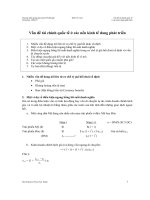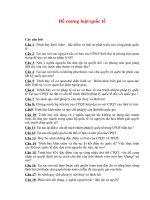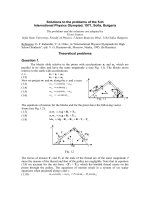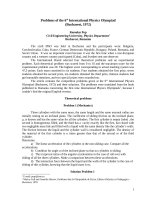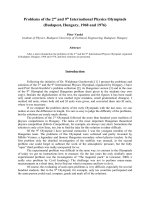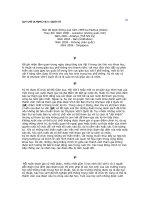Đề IPHO(vật lí quốc tế) 1967
Bạn đang xem bản rút gọn của tài liệu. Xem và tải ngay bản đầy đủ của tài liệu tại đây (165.58 KB, 13 trang )
Problems of the 1st International Physics Olympiad
1
(Warsaw, 1967)
Waldemar Gorzkowski
Institute of Physics, Polish Academy of Sciences, Warsaw, Poland
2
Abstract
The article contains the competition problems given at he 1
st
International Physics
Olympiad (Warsaw, 1967) and their solutions. Additionally it contains comments of historical
character.
Introduction
One of the most important points when preparing the students to the International
Physics Olympiads is solving and analysis of the competition problems given in the past.
Unfortunately, it is very difficult to find appropriate materials. The proceedings of the
subsequent Olympiads are published starting from the XV IPhO in Sigtuna (Sweden, 1984). It
is true that some of very old problems were published (not always in English) in different books
or articles, but they are practically unavailable. Moreover, sometimes they are more or less
substantially changed.
The original English versions of the problems of the 1
st
IPhO have not been conserved.
The permanent Secretariat of the IPhOs was created in 1983. Until this year the Olympic
materials were collected by different persons in their private archives. These archives as a rule
were of amateur character and practically no one of them was complete. This article is based on
the books by R. Kunfalvi [1], Tadeusz Pniewski [2] and Waldemar Gorzkowski [3]. Tadeusz
Pniewski was one of the members of the Organizing Committee of the Polish Physics Olympiad
when the 1
st
IPhO took place, while R. Kunfalvi was one of the members of the International
Board at the 1
st
IPhO. For that it seems that credibility of these materials is very high. The
differences between versions presented by R. Kunfalvi and T. Pniewski are rather very small
(although the book by Pniewski is richer, especially with respect to the solution to the
experimental problem).
As regards the competition problems given in Sigtuna (1984) or later, they are available,
in principle, in appropriate proceedings. “In principle” as the proceedings usually were
published in a small number of copies, not enough to satisfy present needs of people interested
in our competition. It is true that every year the organizers provide the permanent Secretariat
with a number of copies of the proceedings for free dissemination. But the needs are continually
growing up and we have disseminated practically all what we had.
The competition problems were commonly available (at least for some time) just only
from the XXVI IPhO in Canberra (Australia) as from that time the organizers started putting the
problems on their home pages. The Olympic home page www.jyu.fi/ipho contains the problems
starting from the XXVIII IPhO in Sudbury (Canada). Unfortunately, the problems given in
Canberra (XXVI IPhO) and in Oslo (XXVII IPhO) are not present there.
The net result is such that finding the competition problems of the Olympiads organized
prior to Sudbury is very difficult. It seems that the best way of improving the situation is
publishing the competition problems of the older Olympiads in our journal. The question arises,
however, who should do it. According to the Statutes the problems are created by the local
1
This is somewhat extended version of the article sent for publication in Physics Competitions in July 2003.
2
e-mail:
organizing committees. It is true that the texts are improved and accepted by the International
Board, but always the organizers bear the main responsibility for the topics of the problems,
their structure and quality. On the other hand, the glory resulting of high level problems goes to
them. For the above it is absolutely clear to me that they should have an absolute priority with
respect to any form of publication. So, the best way would be to publish the problems of the
older Olympiads by representatives of the organizers from different countries.
Poland organized the IPhOs for thee times: I IPhO (1967), VII IPhO (1974) and XX
IPhO (1989). So, I have decided to give a good example and present the competition problems
of these Olympiads in three subsequent articles. At the same time I ask our Colleagues and
Friends from other countries for doing the same with respect to the Olympiads organized in
their countries prior to the XXVIII IPhO (Sudbury).
I IPhO (Warsaw 1967)
The problems were created by the Organizing Committee. At present we are not able to
recover the names of the authors of the problems.
Theoretical problems
Problem 1
A small ball with mass M = 0.2 kg rests on a vertical column with height h = 5m. A
bullet with mass m = 0.01 kg, moving with velocity v
0
= 500 m/s, passes horizontally through
the center of the ball (Fig. 1). The ball reaches the ground at a distance s = 20 m. Where does
the bullet reach the ground? What part of the kinetic energy of the bullet was converted into
heat when the bullet passed trough the ball? Neglect resistance of the air. Assume that g = 10
m/s
2
.
Fig. 1
Solution
M
s
h
m v
0
M
s
h
m v
0
Fig. 2
We will use notation shown in Fig. 2.
As no horizontal force acts on the system ball + bullet, the horizontal component of
momentum of this system before collision and after collision must be the same:
.
0
MVmvmv
+=
So,
V
m
M
vv
−=
0
.
From conditions described in the text of the problem it follows that
.Vv
>
After collision both the ball and the bullet continue a free motion in the gravitational
field with initial horizontal velocities v and V, respectively. Motion of the ball and motion of the
bullet are continued for the same time:
.
2
g
h
t
=
It is time of free fall from height h.
The distances passed by the ball and bullet during time t are:
d
v – horizontal component of the velocity
of the bullet after collision
V – horizontal component of the velocity
of the ball after collision
Vts
=
and
vtd
=
,
respectively. Thus
.
2h
g
sV
=
Therefore
h
g
s
m
M
vv
2
0
−=
.
Finally:
s
m
M
g
h
vd
−=
2
0
.
Numerically:
d = 100 m.
The total kinetic energy of the system was equal to the initial kinetic energy of the
bullet:
2
2
0
0
mv
E
=
.
Immediately after the collision the total kinetic energy of the system is equal to the sum
of the kinetic energy of the bullet and the ball:
2
2
mv
E
m
=
,
2
2
MV
E
M
=
.
Their difference, converted into heat, was
)(
0 Mm
EEEE
+−=∆
.
It is the following part of the initial kinetic energy of the bullet:
.1
00
E
EE
E
E
p
Mm
+
−=
∆
=
By using expressions for energies and velocities (quoted earlier) we get
+
−=
m
mM
g
h
s
v
h
g
v
s
m
M
p
2
2
2
0
2
0
2
.
Numerically:
p = 92,8%.
Problem 2
Consider an infinite network consisting of resistors (resistance of each of them is r)
shown in Fig. 3. Find the resultant resistance
AB
R
between points A and B.
Fig. 3
Solution
It is easy to remark that after removing the left part of the network, shown in Fig. 4 with
the dotted square, then we receive a network that is identical with the initial network (it is result
of the fact that the network is infinite).
Fig. 4
Thus, we may use the equivalence shown graphically in Fig. 5.
Fig. 5
Algebraically this equivalence can be written as
AB
AB
Rr
rR
11
1
+
+=
.
Thus
A
rrr
rrr
A
B
rrr
rrr
A
B
R
AB
R
AB
r
r
⇔
